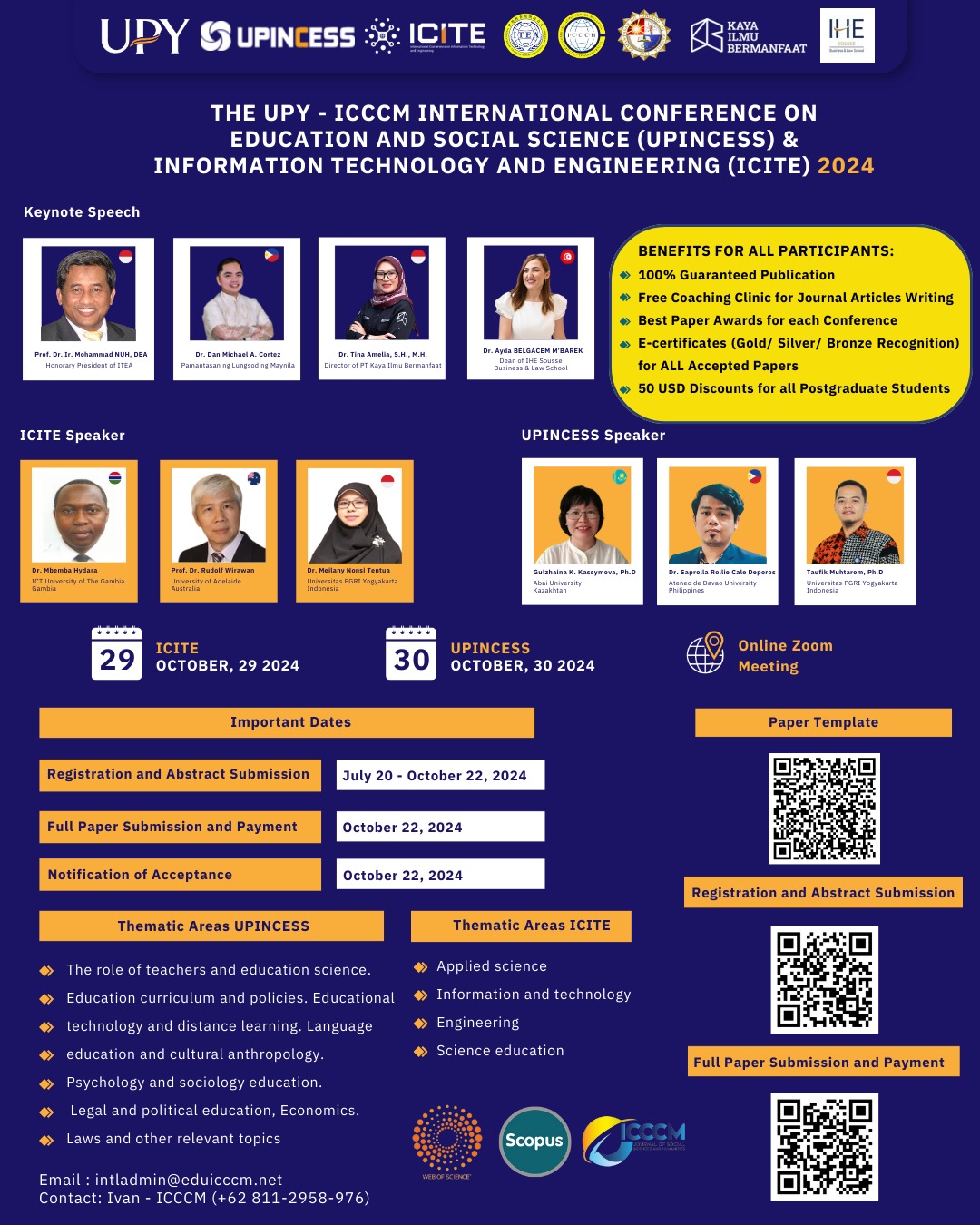The Influence of Flipped Classroom Learning Assisted by Plickers on Student Motivation and Learning Outcomes
DOI:
https://doi.org/10.53797/icccmjssh.v3i5.7.2024Keywords:
Flipped Classroom, learning outcomes, motivation, PlickersAbstract
This study objectives are (1) to analyze the effect of the Flipped Classroom Learning model with online-based assessment on the learning motivation of elementary school mathematics in Cluster Gunung Agung, Mijen District, Demak Regency. (2) Analyzing the effect of the Flipped Classroom Learning model with online-based assessment on the learning outcomes of elementary school mathematics in Cluster Gunung Agung, Mijen District, Demak Regency. This study uses an experimental method with a Quasi-Experimental model with a simple experimental design (Pretest and Posttest Control Group Design). The population of this study were 6th grade students of Public Elementary School in the Gunung Agung Cluster, Mijen District, Demak Regency. The sample in this study were 6th grade students of SD Negeri Gempolsongo as the experimental class (flipped classroom) and 6th grade students of SD Negeri Bermi as the control class. The sampling technique that will be used in this study is purposive sampling. The research variable is the flipped classroom learning model as the independent variable (X) while the dependent variable is learning motivation (Y1) and learning outcomes (Y2). The research instruments are tests and questionnaires. Data analysis used data descriptions, prerequisite tests included normality tests and homogeneity tests, while hypothesis testing used the Manova test (Multivariate Analysis of Variance).
Downloads
References
Adhami, N., & Taghizadeh, M. (2024). Integrating inquiry-based learning and computer supported collaborative learning into flipped classroom: Effects on academic writing performance and perceptions of students of railway engineering. Computer Assisted Language Learning, 37(3), 521-557. https://doi.org/10.1080/09588221.2022.2046107
Bergmann, J., & Sams, A. (2012). Flip your classroom: Reach every student in every class every day (1st Eds). International society for technology in education. Virginia, ISTE & ASCD.
Brown, L. S., & Lewis, K. (2022). The elementary forms of digital communication. Plos one, 17(9), e0273726. https://doi.org/10.1371/journal.pone.0273726
Egara, F. O., & Mosimege, M. (2024). Effect of flipped classroom learning approach on mathematics achievement and interest among secondary school students. Education and Information Technologies, 29(7), 8131-8150. https://doi.org/10.1007/s10639-023-12145-1
Fiuza-Fernández, A., Lomba-Portela, L., Soto-Carballo, J., & Pino-Juste, M. R. (2022). Study of the knowledge about gamification of degree in primary education students. Plos one, 17(3), e0263107. https://doi.org/10.1371/journal.pone.0263107
Gómez-Carrasco, C. J., Monteagudo-Fernández, J., Moreno-Vera, J. R., & Sainz-Gómez, M. (2020). Evaluation of a gamification and flipped-classroom program used in teacher training: Perception of learning and outcome. PloS one, 15(7), e0236083. https://doi.org/10.1371/journal.pone.0236083
Karagöz, B., Karatop, H., & Erdönmez, A. (2024). Rethinking Classrooms: A Comprehensive Analysis Of Postgraduate Theses On The Flipped Classroom Model İn Turkey. Journal of Advanced Education Studies, 6(1), 134-169. https://doi.org/10.48166/ejaes.1486948
Khapper, K. V., AlHmoud, I. W., Gokaraju, B., Islam, A. K., & Graves, C. A. (2024, March). A Low-Power IoT-Based Smart Desk Integrated with a Classroom Response System. In SoutheastCon 2024 (pp. 1591-1598). IEEE. https://doi.org/10.1109/SoutheastCon52093.2024.10500186
Lepkova, N., Gülseçen, S., & Talan, T. (2024). Flipped classroom method application case study analysis. Baltic Journal of Modern Computing, 12(2).
Menino, H., Reis, S., & Oliveira, A. (2024). Portuguese Students'perceptions Of The Flipped Classroom: A Case Study In Didactics Of Mathematics In Higher Education. Journal of Global Business and Technology, 20(2), 20-33.
Septiani, R., Muluk, S., & Habiburrahim, H. (2024). The implementation of the flipped classroom approach to improve the EFL students’ reading ability. Englisia: Journal of Language, Education, and Humanities, 11(2), 181-198. http://dx.doi.org/10.22373/ej.v11i2.22732
Shoukat, R., Ismayil, I., Huang, Q., Oubibi, M., Younas, M., & Munir, R. (2024). A comparative analysis of blended learning and traditional instruction: Effects on academic motivation and learning outcomes. PloS one, 19(3), e0298220. https://doi.org/10.1371/journal.pone.0298220
Tinjić, D., & Nordén, A. (2024). Crisis-driven digitalization and academic success across disciplines. Plos one, 19(2), e0293588. https://doi.org/10.1371/journal.pone.0293588
Zainuddin, Z. (2024). Gamification in a Flipped Classroom: Pedagogical Methods and Best Practices. Springer Nature.
Zhonggen, Y. (2019). Video lecturing in Clicker-assisted English flipped class. Plos one, 14(10), e0224209. https://doi.org/10.1371/journal.pone.0224209
Downloads
Published
How to Cite
Issue
Section
License
Copyright (c) 2024 Viki Fandi Hardika, Eko Darmanto, Sri Utaminingsih, Lily Muliana

This work is licensed under a Creative Commons Attribution-NonCommercial-ShareAlike 4.0 International License.




